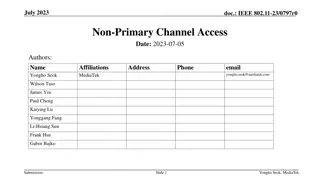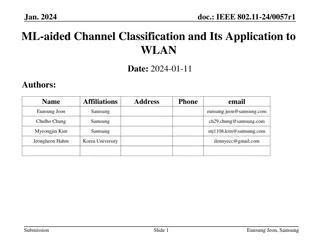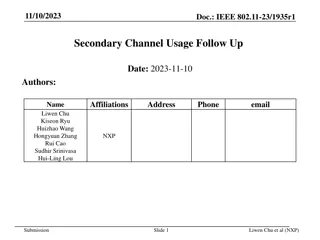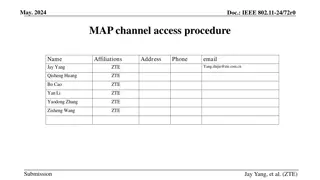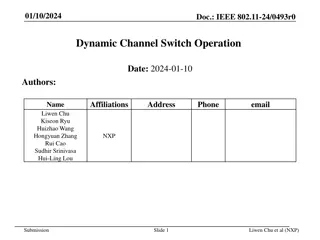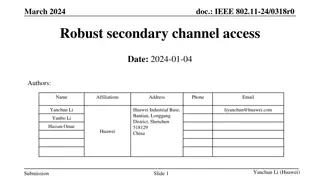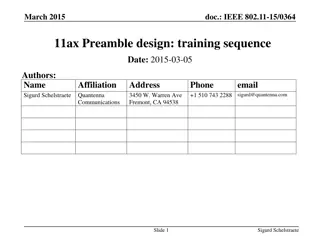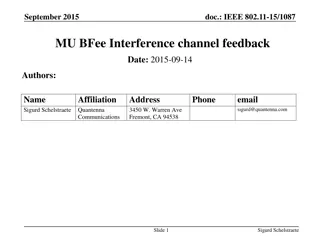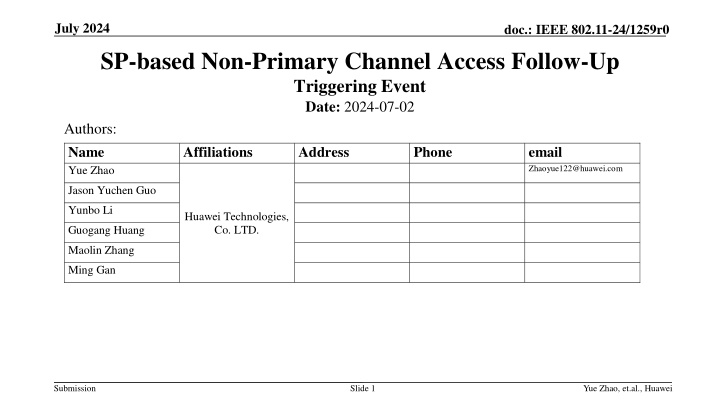
Improving Channel Utilization with SP-Based Non-Primary Channel Access
Explore the concept of Non-Primary Channel Access (NPCA) in IEEE 802.11-24/1259r0 document for enhancing channel utilization in scenarios where the primary channel is frequently occupied by Other BSS (OBSS). SP-based NPCA aims to address throughput and latency requirements by allowing stations to park on non-primary channels during OBSS Spatial Protection (SP) periods, minimizing the need for frequent channel switching. Learn more about triggering events, channel access recommendations, and implications for network performance.
Download Presentation

Please find below an Image/Link to download the presentation.
The content on the website is provided AS IS for your information and personal use only. It may not be sold, licensed, or shared on other websites without obtaining consent from the author. If you encounter any issues during the download, it is possible that the publisher has removed the file from their server.
You are allowed to download the files provided on this website for personal or commercial use, subject to the condition that they are used lawfully. All files are the property of their respective owners.
The content on the website is provided AS IS for your information and personal use only. It may not be sold, licensed, or shared on other websites without obtaining consent from the author.
E N D
Presentation Transcript
July 2024 doc.: IEEE 802.11-24/1259r0 SP-based Non-Primary Channel Access Follow-Up Triggering Event Date: 2024-07-02 Authors: Name Yue Zhao Affiliations Address Phone email Zhaoyue122@huawei.com Jason Yuchen Guo Yunbo Li Huawei Technologies, Co. LTD. Guogang Huang Maolin Zhang Ming Gan Submission Slide 1 Yue Zhao, et.al., Huawei
July 2024 doc.: IEEE 802.11-24/1259r0 Motivation To meet throughput and latency requirements mentioned in the UHR PAR [1], non- primary channel access (NPCA) was proposed as a potential method [1] The general idea of SP-based NPCA was introduced in [2] Submission Slide 2 Yue Zhao, et.al., Huawei
July 2024 doc.: IEEE 802.11-24/1259r0 Recap: SP-based NPCA The main goal is to improve channel utilization for cases where primary channel is frequently occupied by OBSS, e.g., during OBSS TWT SP According to the current spec where STAs have to access the medium via the primary channel, it would be less probable for myBSS to access the channel (with more collision), leading to higher delay With TXOP-based NPCA where the NPCA STA switches back to the primary channel before NAV for the primary channel expires, there are frequent switching; considering time spent on medium sync recovery and switching delay, time overhead due to frequent switching is not negligible SP-based NPCA: Switch to a non-primary channel without switching back and forth during an OBSS SPs The basic idea is for myBSS to park on a non-primary channel during the OBSS SP frequency Non-primary channel myBSS parking myBSS parking Primary channel OBSS TWT SP myBSS parking OBSS TWT SP myBSS parking [2] time Submission Slide 3 Yue Zhao, et.al., Huawei
July 2024 doc.: IEEE 802.11-24/1259r0 Triggering Event Within the OBSS TWT SP, if the OBSS PPDU is detected on the primary channel, then switch The OBSS PPDU belongs to an OBSS whose ongoing TWT SP is announced by the BSS AP This is not within any of BSS 2 s TWT agreements announced by BSS 1, so it won t cause BSS 1 switching if TXOP- based NPCA is not used outside (i.e., out of scope of SP-based NPCA). TWT 2 SP of BSS 2 BSS 1 could park on the primary channel until BSS 2 s PPDU is detected within TWT 2 BSS 1 (my BSS) BSS 1 switches to a non-primary channel BSS 1 announces TWT 2 of BSS 2 BSS 2 (OBSS) Although BSS 3 is an OBSS, it has no ongoing TWT SP announced by BSS 1 at the time, so this PPDU won t cause BSS 1 switching BSS 3 (OBSS) * for convenience, contention is omitted, frame exchange within a BSS is simplified Submission Slide 4 Yue Zhao, et.al., Huawei
July 2024 doc.: IEEE 802.11-24/1259r0 If Switching, When parking on a non-primary channel, the BSS (i.e., PPDUs transmitted by AP and non-AP in the BSS) is recommended to switch to a non-primary channel that is not adjacent from current OBSS transmission to avoid ACI This is an implicit signaling of I am on a non-primary channel Accessing the channel on the non-primary channel until the end of the SP TWT 2 SP of BSS 2 Accessing the medium on the non-primary channel until the end of the SP BSS 1 (my BSS) BSS 1 announces TWT 2 of BSS 2 BSS 2 (OBSS) BSS 3 (OBSS) * for convenience, contention is omitted, frame exchange within a BSS is simplified Submission Slide 5 Yue Zhao, et.al., Huawei
July 2024 doc.: IEEE 802.11-24/1259r0 Example Scenario: BSS 1 announces rTWT 2 and 3; BSS 2 announces rTWT 1 and 3; BSS 3 announces rTWT 1 and 2; rTWT 1,2, and 3 are aligned. The BSS that transmits the first PPDU within the SP (e.g., BSS 1 in the figure below) claims the primary channel, and the remaining BSSs (e.g., BSS 2 and 3 in the figure) switch to non-primary channel. SP of rTWT 1, 2, 3 rTWT 1,2,3 can be a coordinated rTWT, or non- coordinated rTWT with overlapping SPs Taking rTWT as an example, the mechanism can be applied to other kinds of TWTs, e.g., TWT for PS BSS 1 BSS 2 Accessing the medium on the non-primary channel until the end of the SP BSS 1 rTWT 1 BSS 3 Accessing the medium on the non-primary channel until the end of the SP * for convenience, contention is omitted, frame exchange within a BSS is simplified BSS 3 rTWT 3 BSS 2 rTWT 2 Submission Slide 6 Yue Zhao, et.al., Huawei
July 2024 doc.: IEEE 802.11-24/1259r0 Comparison During OBSS TWT SP SP-based NPCA TXOP-based NPCA PPDU Validation Time and Source are validated - there is an ongoing SP and - the PPDU is from the OBSS which has the ongoing SP Source is validated - The PPDU is from an OBSS (not required) NAV Validation CTS or data after RTS Type of Triggering PPDU/Frame - HE/EHT/UHR PPDU? Same Time When to switch PPDU is validated (a frame) NAV is validated (frame exchange) Stay on NPCA until The end of the SP on primary The end of the TXOP on primary Time Overhead - For medium sync recovery and switching low high Submission Slide 7 Yue Zhao, et.al., Huawei
July 2024 doc.: IEEE 802.11-24/1259r0 Summary Within OBSS TWT SPs, a BSS (both AP and non-AP STAs) Parks on the primary channel until a PPDU from the OBSS is detected, switch to a non-primary channel that is not adjacent from current OBSS transmission, and Switches back to the primary channel at the end of the OBSS TWT SP Comparison between SP-based NPCA and TXOP-based NPCA Whether to switch is decided at the beginning of a PPDU for SP-based NPCA, whereas the decision is made at least after a frame exchange for TXOP-based NPCA Time overhead is lower with SP-based NPCA when primary is frequently occupied by OBSS, e.g., during OBSS TWT SPs Submission Slide 8 Yue Zhao, et.al., Huawei
July 2024 doc.: IEEE 802.11-24/1259r0 References [1] 11-24/0209r3, Specification Framework for TGbn, Ross Jian Yu [2] 11-24/0538r1, SP-based Non-Primary Channel Access, Yue Zhao Submission Slide 9 Yue Zhao, et.al., Huawei



